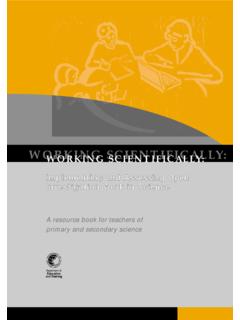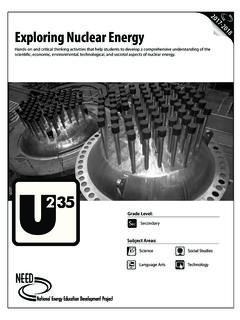Transcription of Friction Lab - VDOE
1 Science Enhanced Scope and Sequence Grade 4 virginia department of education 2012 1 Friction Lab Strand Force, Motion, and Energy Topic Investigating motion Primary SOL The student will investigate and understand characteristics and interactions of moving objects. Key concepts include c) Friction is a force that opposes motion. Related SOL The student will demonstrate an understanding of scientific reasoning, logic, and the nature of science by planning and conducting investigations in which a) distinctions are made among observations, conclusions, inferences, and predictions; c) appropriate instruments are selected and used to measure length, mass, volume, and temperature in metric units; e) predictions and inferences are made, and conclusions are drawn based on data from a variety of sources; f) independent and dependent variables are identified.
2 G) constants in an experimental situation are identified; h) hypotheses are developed as cause and effect relationships; i) data are collected, recorded, analyzed, and displayed using bar and basic line graphs; j) numerical data that are contradictory or unusual in experimental results are recognized; k) data are communicated with simple graphs, pictures, written statements, and numbers; m) current applications are used to reinforce science concepts. Background Information Friction can be described as the resistance to motion created by two objects moving against each other.
3 This force can be either helpful or a hindrance. In order for a car to turn, stop, and even begin moving a certain amount of Friction is helpful. Too much Friction could stop a car from ever moving at all. Without Friction , running, walking, picking up a toothbrush and even standing would be a difficult chore. Most machine inventors try to reduce the Friction on the working parts to increase efficiency. For example, car engines need clean lubricant to reduce Friction to help moving parts work efficiently. If the lubricant becomes too dirty, the dirt particles will provide too much Friction inside the moving parts and may cause the engine to overheat and shut down.
4 Another example to illustrate the decrease in efficiency due to resistance might be to compare two pairs of scissors. One may be rusty and hard to move while the other is clean, new, and easy to maneuver. The rusty scissors illustrate how too much Friction can cause a compound machine like scissors to become less efficient. Science Enhanced Scope and Sequence Grade 4 virginia department of education 2012 2 Materials For each student: Copies of the attached Friction Lab worksheet Grid paper Science journal or loose leaf paper For each small group, a box that includes.
5 One toy car Ramp 2 meter sticks 3 different surfaces for the car to roll over ( , carpet, tile, sandpaper, or felt) Small amount of tape Vocabulary Friction , hypothesis, constant, independent variable, dependent variable, conclusion, meter stick, quantitative data, qualitative data Student/Teacher Actions (what students and teachers should be doing to facilitate learning) Introduction 1. Ask students if they know that there has been a war going on for war against unwanted Friction . Remind students about the definition of Friction .
6 2. Discuss what they think you mean by this. To prompt students, have them name times when Friction made something more difficult for them. 3. After they name a few, have them name times that Friction has helped them do something. 4. Tell students that they will be designing an experiment to test the effect of Friction on different objects. Procedure 1. Give students the box of materials and the attached Friction Lab worksheet . 2. Have students review the Friction Lab worksheet and plan their experiment with their group, filling in Step 1 on the sheet.
7 3. After they have discussed their plan and are ready to execute, let them know it is acceptable to change some aspects of their experiment when a problem is found, but not to erase their first attempts so that they can be discussed later. 4. Students will then complete their experiment and record the data on the Friction Lab worksheet . 5. Circulate and observe the experiment process to assist where needed. Conclusion 1. Ask each individual student to independently complete question number twelve on the Friction Lab worksheet to apply what he/she has learned.
8 2. Discuss student results from their experiments and what changes they made to their design. Science Enhanced Scope and Sequence Grade 4 virginia department of education 2012 3 3. During discussion, questions will inevitably be generated and students will be excited to try another design. This may be a good time to encourage the design of another experiment and then the completion of that Friction experiment if you have time. Assessment Questions o How does Friction help us? o How did the data you collected prove or disprove your hypothesis?
9 Journal/writing prompts o Imagine traveling to a planet with gravity, but no Friction . What problems would arise? Can you think of any solutions? o Today, many companies make tires for bikes. There are specialized tires for every terrain. Why does it matter what type of tires are on your bike? Explain. Other o Have students write a paragraph evaluating their own experiment. Have them tell what worked well and what didn t work well. Extensions and Connections (for all students) Go to the school parking lot and look at the vehicles.
10 Have students discuss the different shapes of cars, the possible problems or advantages of certain tire types, sizes, and treads, and any other aspects of the vehicles that may relate to Friction and/or efficiency. Put a large, heavy box on the floor in the room. Have students try to list ways to move it in the easiest way possible. Remind them to reduce Friction if necessary. Create a Friction bulletin board collage in the classroom. Have students take pictures of Friction in real life and bring them in to put on the board. Each time a child brings a picture in, have others tell where the Friction is and whether it is helpful or not.












